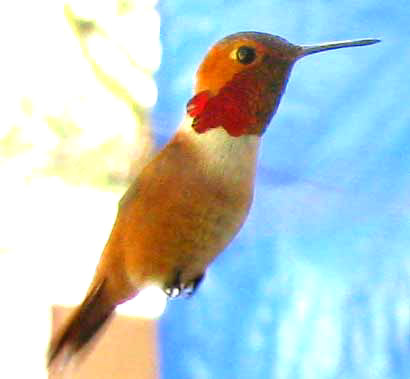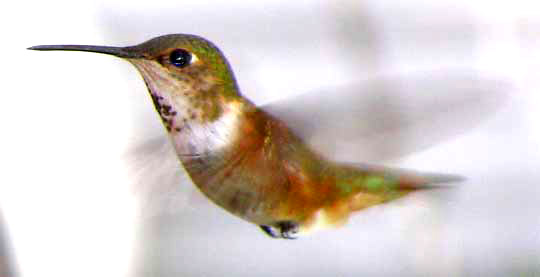Excerpts from Jim Conrad's
Naturalist Newsletter
from the April 26, 2009 Newsletter, issued from the Siskiyou Mountains west of Grants Pass, Oregon:
RUFOUS HUMMINGBIRD FEISTINESS
My friends hang hummingbird feeders just outside their picture windows so when I arrived I asked which species occur here. "Mainly Anna's, who stay through the winter," they replied, "but during the warm months we also get a lot of Rufous Hummingbirds and occasionally a Calliope."
The hummers visiting those feeders are not at all shy. When a refilled feeder is being replaced a bird might start feeding before it's even hung. While I was photographing them it was nothing to have six or more buzzing within two or three feet of me. They're so fast, however, even having them so close I couldn't confirm which species they were. You can see a male with his red throat and invisible wings below:

A female or immature is shown hovering below:

Though I'd expected most if not all the birds in the 30 or so pictures I snapped that morning to be Anna's, every one turned out to be a Rufous Hummingbird, SELASPHORUS RUFUS. Where were the Anna's?
The hummingbirds visiting my friends' feeders throughout the winter are certainly Anna's, for other species possible for here all overwinter in Mexico. Also my friends say that Anna's had been visiting that morning before I got there. Maybe the Rufouses are less shy about being around humans? Or maybe that morning they were simply dominating the feeder, for Rufous Hummingbirds are a vigorous, aggressive species.
At http://www.hummingbirds.net/rufous.html I read that "This bird outflies all other species, and usually gets its way at feeders at the expense of slower, less-maneuverable hummers... The Rufous has the longest migration route of all US hummingbirds."
Also, the species is expanding its distribution greatly. My 1966-copyrighted field guide shows Rufouses restricted to the far west, mostly the US Pacific Northwest and coastal Canada and southern Alaska. The above website says that nowadays it's being "Observed in every state and province except Hawaii, Prince Edward Island, and Quebec. There was even one very unusual report from extreme eastern Siberia! The Rufous is the most widely-distributed hummingbird in North America."
The East's Ruby-throated Hummingbirds wear none of the rusty-red or "rufous" color seen on both sexes of the Rufous. If you're in North America and someday you see a hummingbird species other than what your field guide says ought to be in your area, check whether the bird has a lot of rusty-red feathers, for there's a good chance a Rufous Hummingbird will eventually move into your neighborhood!